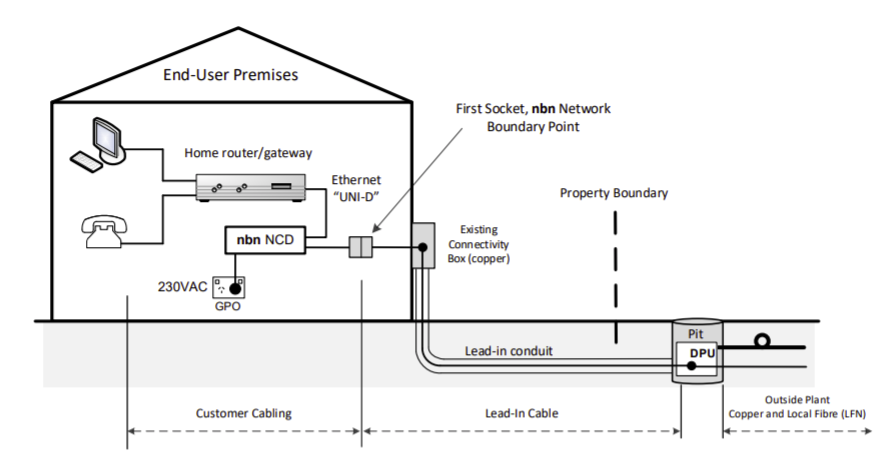Recently, ACMA / Communications Alliance updated the rules defining cabling – S009 – “Installation requirements for customer cabling” aka the “Wiring Rules” or “Cabling Bible”.
I don’t talk much about cabling on this blog – but I’m still a registered cabler so need to keep up to date on the changes, and quite a lot has changed since the last update in 2013 – Authority to Alter (A2A) has moved from Telstra to NBNco, PayTV over HFC is far less common, and the NBN rollout is “finished”.
So what are the key changes I need to know about? I had a read and compared to S009 / 2013, and here are they are:
“Supervised” Definition
In order to gain cabling registration you need 360 hours of supervised cabling experience. The specification has been updated to define exactly what supervised means,
4.2.59 instructed person
a person instructed or supervised by a Skilled Person as to energy sources and who can responsibly use equipment safeguards and precautionary safeguards with respect to those energy sources.
Note: Supervised, as used in the definition, means having the direction and oversight of the performance of others.
ES3 (Electrical energy source class 3 (ES3)) Definition & Rules
Reverse power feed, used in NBN FTTC tech, as well as higher voltages used for EWIS and PA systems, has led to the introduction of a new classification – ES3, for cabling that exceeds the ES2 limits,
a metallic circuit utilised for communications or Power Feeding, or both, that—
4.2.45 ES3 generic circuit
(a) exceeds the ES2 voltage and touch current limits;
(b) does not exceed 400 V d.c. between conductors; and
(c) does not exceed current as specified in AS/NZS 11801.1 or ISO/IEC 11801-1.
ES3 falls into two categories, which specific whether it can be carried over generic cabling or not,
(a) over Generic Cabling, in this Standard, are based on—
F.2
(i) circuit voltage not exceeding 400 V d.c. between conductors; and
(ii) circuit current not exceeding that specified in AS/NZS 11801.1 or ISO/IEC 11801-1.
Where voltages and currents exceed these limits, then Special Application Cabling, as classified in Item F.2(b), should be used.
(b) over Special Application Cabling in this Standard, are based on a voltage limit and current limit set by Cable manufacturer for the specific Cable and its installation requirements
So if part a is exceeded, Special Application cabling is required;
- the cabling must meet a higher standard defined for ES3
- must be identified by it’s sheath colour and markings at regular intervals
- cabling has to be separated from other services (sub-ducted or separated by a barrier or more than 150mm)
- must carry a warning label wherever the conductive part of the circuit is exposed (frames / joints) stating it is an ES3 service
- service may not be terminated on a plug if the plug may have exposed contacts (requires a plug / socket with shutters)
RFT (Remote feeding telecommunication circuit) Definition
an equipment circuit within the ICT Network not connected to Mains power, intended to supply or receive DC power at voltages exceeding the limits of ES2, and on which transient overvoltages or overcurrents may occur.
4.2.85
Examples are PoE, ring current, USB-C / USB3, etc.
RFT circuits are classified as ES3 circuits and subject to the same conditions.
New Conductor Size / Temperature Recommendations
S009 / 2013 did not specific recommended (not mandated) size & temperature rating for generic cabling / jumpering.
It comes down to:
“have a maximum conductor resistance of 0.0938 Ω/m at 20° C “
5.6.2
and
“the cable should not be installed in a manner that may cause the maximum operating temperature rating of the Cable to be exceeded.”
Plug Terminated Cabling Requirements
Moveable cabling / plug terminated cabling must not be used unless:
the Plug is an integral part of a device that is fastened to a
5.9.1
wall, floor or ceiling or other permanent building element; or
(b) the Plug is not fixed and—
(i) the Plug terminates a section of Movable Cabling;
(ii) the Plug is to mate with a Port on an item of fixed Customer Equipment; and
(iii) in every position to which it may be moved when the Plug is not mated with the Port, every part of the section of Movable Cabling is either out of Arm’s Reach or housed in a Secure Enclosure that is fastened to a wall, floor or ceiling or other permanent building element.
Network Boundary Definition Update
A new Appendix (J) has been added with updated (informative only) definitions of Network Boundaries with examples, to support all the new network boundary definitions introduced with the access technology mix(fibre, HFC and wireless terminations).
FTTC Deployment Information (Informative)
A new Appendix (O) has been added providing information in regards to FTTC and it’s requirement to isolate the first socket from the rest of the cabling – Something that in practice seems to be a rarity.

Labelling & Safety Rules for Fibre Optic Cabling
A new requirement has been added to 11.1 in regards to Fibre Optic cabling must:
- Have a Warning of potential hazardous laser levels
- Have a warning regarding Access to emitted radiation
- Types of laser warning markings
- Laser warning marking style
- Laser explanatory label wording
- Marking durability of labels
- Fibre outlets in work areas are except
- Groups of optical fibre connectors may be marked as a group
- Multiple markings – ie one inside the container one outside
- Unused optical fibre connectors and adaptors must be covered
Of course, this is all just a summary of the changes I thought were key, but you can get the latest version of S009 from the Comms Alliance website.
Do your records!
